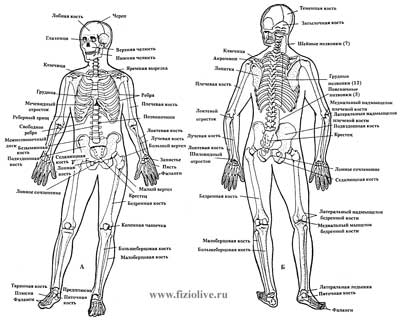
| HOME | MENU | DOCS | SEARCH |
Translations of articles in the English language
is in automatic mode, the original version
of the article in Russian - here
The content of the article "Anthropometry: Assessment of physical development":
External examination (somatoscope)
Determination of the density and composition of body weight
The definition of absolute lean muscle mass
Measurement of flexibility and mobility
Tests and evaluation of power performance and mobility
Determination of water content in body weight
Under the physical development of man to understand the complex functional-morphological properties of the organism, which determines its physical capacity. This complex concept includes such factors as health, physical development, body weight, level of aerobic and anaerobic capacity, strength, muscular endurance, coordination, motivation, etc.
On the physical development of man is influenced by heredity, environment, socio-economic factors, conditions of work and life, nutrition, physical activity, playing sports.
It is known that health is determined not only by the presence or absence of disease, but also harmonious development, the normal level of the main functional parameters. Therefore, one of the main directions in the work of health promotion means of medical physical education is monitoring the impact of physical education and sport physical consists of.
According to the program developed by the International Committee on standardization of tests of physical readiness, performance measurement should take place in four areas:
1) medical inspection;
2) identifying physiological responses of different body systems to physical activity;
3) determine the physique and body composition in correlation with physical performance;
4) determination of the ability to perform physical activity and movements in the exercise, the Commission of which depends on different body systems.
The main methods of research of physical development of a person are external examination (somatoscope) and measurement — anthropometry (somatometry).
In the study of physical development of a person along with the data obtained by instrumental methods, take into account and descriptive indicators.
Begin the examination with assessment of the skin, then the shape of the chest, abdomen, legs, development of muscles, irouleguy, condition of the musculoskeletal system and other parameters (indicators).
The skin is described as smooth, clean, wet, dry, elastic, listless, Prista, pale, flushed, etc.
The condition of the musculoskeletal system (ODE) evaluated on the overall impression of massiveness, width of shoulders, posture, etc.
The spine — performs the main supporting function (see Fig. The human skeleton). His inspect in the sagittal and frontal planes, determined the shape of the line formed by the spinous processes of the vertebrae, pay attention to the symmetry of the shoulder blades and the shoulder level, the state of the triangle waist formed by the waist and lowered by hand (see Fig. The definition of the curvature of the spine).
The human skeleton
The human skeleton (a — front view; b — rear view)
Definition of spinal curvature
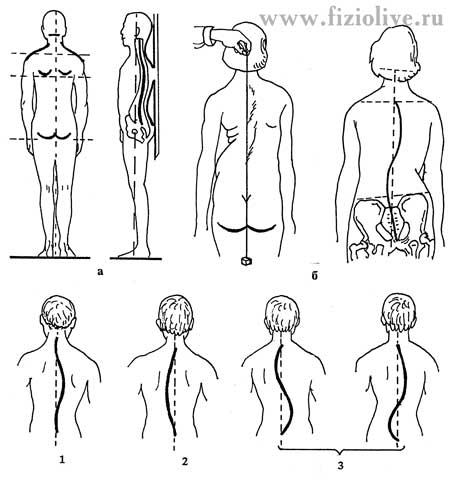
The signs of a normal posture (a); the definition of the curvature of the spine (b).
Types of scoliosis: 1 — right; 2 — left; 3 — S-shaped
The normal spine has physiological curves in the sagittal plane, full face is a straight line. In pathological conditions of the spine for possible curvature in the anterior-posterior direction (kyphosis, lordosis) and lateral (scoliosis).
To determine the lateral curvatures of the spine using scoliometer Billy-Kirchhofer (see Fig. Lotsoptimized).
Lotsoptimized
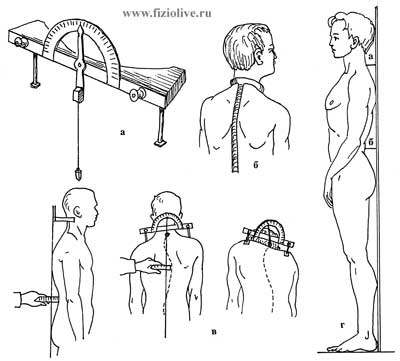
Lotsoptimized (a). Definition of lateral curvatures of the spine by the device Billy-Kirchhofer (b), lidapischekontsentraty P. I. Belousov (v); d — scheme of measuring the depth cervical (a) and lumbar (b) bend
A flat spin is characterized by flattening of physiological curvatures of the spine.
Round the back (stolovitch) is a form of thoracic kyphosis.
When krugovorote back at the same time increased thoracic kyphosis and lumbar lordosis.
When-concave — increased lumbar lordosis.
Posture — habitual posture relaxed standing person. It depends on the shape of the spine, uniform development and toning the musculature of the torso. Distinguish posture is correct, round-shouldered, kyphotic, lidodijesolo and straightened (see Fig. Types of posture). For determining the posture is carried out visual observation of the position of the blades, the shoulders, the position of the head. In addition, include instrumental assessment (determination of the depth of the cervical and lumbar curves and the length of the spine).
Types of posture
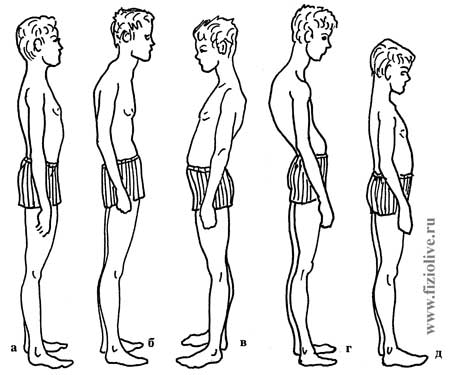
Types of posture: a — normal; b — stooping; in — legationsrat; g — kyphotic; d — straightened (flat)
Normal posture is characterized by five features (see Fig. Definition of spinal curvature; Normal posture):
1 — location of the spinous processes of the vertebrae to the plumb line dropped from the tuberosity of the occipital bone and extending along mezhyagodichnoy folds;
2 — location of napley at the same level;
3 — location of both blades at the same level;
4 equal triangles (right and left) formed by the torso and freely lowered hands;
5 — proper curves of the spine in the sagittal plane (a depth of 5 cm in the lumbar spine and up to 2 cm in cervical).
Normal posture
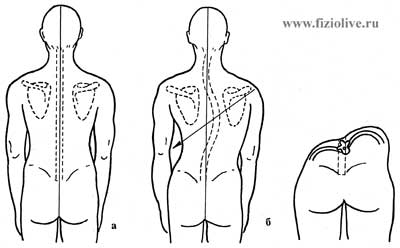
Normal posture (a) scoliosis (b)
In a number of diseases (scoliosis, kyphosis, etc.) there is a change of posture (see Fig. Normal posture). Often classes relevant sport, early specialization (gymnastics, barbell, etc.) lead to the disorder function of the spine and muscle imbalance that affects the function of internal organs and human performance in General.
In determining the form of the legs of the inspected connects the heels together and stands straight. Normal feet are touching in the area of the knee, with O-shape knee joints not touching, X-shaped one knee comes after the other (see Fig. The shape of the feet).
The shape of the feet
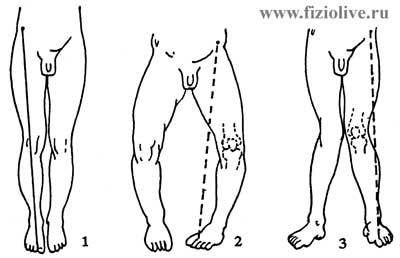
Toe shape: 1 — normal (the axis of the lower limb in normal); 2 — O-shaped deformity of the lower limbs (varus); 3 — shape (deformation of the lower extremity (valgus)
The feet — body support and movement. Distinguish normal foot, flat and flattened (see Fig. The appearance of the feet and their prints). When viewed from the foot support surface pay attention to the width of the isthmus that connects the heel area with the front part of the foot. In addition, pay attention to the vertical axis of the Achilles tendon and the heel under load.
The appearance of the feet and their prints
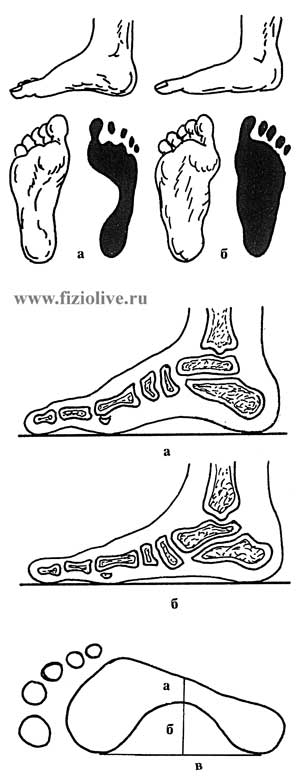
The appearance of the feet and the prints of the soles of their normal (a) and flat (b). Schematic representation of foot bones in normal (a) and in longitudinal flat (b). Determination of the shape of the foot (C): a — width of isthmus; a + b — width foot
In addition to the inspection, you can get the prints of a foot (plantography). The degree of flattening of the foot is calculated according to the method Striter (see Fig. The appearance of the feet and their prints).
Examination of the chest is needed to determine its form, symmetry of respiration in both halves of the chest and breathing.
The shape of the chest, respectively, constitutional types, there are three types: normosthenic, asthenic and hypersthenic. Often the chest is a mixed form.
Asthenic form of the chest is characterized by proportionality ratios between anteroposterior and transverse to its size, over - and subclavian space is moderately expressed. The scapula firmly against the rib cage, the intercostal spaces are mild. Epigastric angle approaching straight and equal to about 90°.
Asthenic form of the chest is quite flat, because the front-back dimension smaller than the transverse. Over- and subclavian space sink, the blades are spaced from the rib cage. Edge X free edge and is easily located by palpation. Epigastric angle is acute — less than 90°.
Hypersthenic form of the chest. Anterior-posterior diameter is more asthenic, and therefore a cross section approaching a circle. Intercostal spaces are narrow, supra - and subclavian space is poorly expressed. Epigastric angle obtuse — greater than 90°.
Pathological shapes of the chest are developing under the influence of disease processes in the chest cavity or during the deformation of the skeleton. Do athletes is often found in funnel-chest, rachitic, navicular, etc.
The shape of the chest can also be affected by different types of spinal curvature. So, kyphotic curvature of the spine is often combined with simultaneous scoliosis, and is called kyphoscoliosis, and his chest gipokaliemicski.
In the study of the chest should also pay attention to the type of respiration, its frequency, depth and rhythm. There are the following types of breathing: thoracic, abdominal and mixed. If respiratory movements are mainly due to the contraction of the intercostal muscles, it is called thoracic, or costal, breathing. It applies primarily to women. Abdominal type of breathing characteristic of men. Mixed type, in which the breathing involved the lower parts of the chest and upper abdomen, typical for athletes.
Development of muscles is characterized by a number of muscle tissue, elasticity, relief, etc. About the development of advanced musculature is judged by the position of the blades, the shape of the abdomen. muscle Development largely determines the strength and endurance of the person and the sport he's involved in.
The degree of sexual development — an important part of the characteristics of the physical development of pupils and is determined by the totality of secondary sexual characteristics: hairiness of pubic and underarm area, in addition, girls - on the development of breast cancer and the advent of menstruation, the young men - for the development of hair on the face , the Adam's apple and mutation voices.
Body type is determined by the size, form, proportion (the ratio of one size of the body with the other) and peculiarities of the mutual arrangement of parts of the body. On the physique affect sport, food, environment (climatic conditions) and other factors. The Constitution is a particular physique of the person. M. V. Chernorutsky differentiates between three types of Constitution (see Fig. Body types): hypersthenic, asthenic and normosthenic. The author takes into account both morphological and functional peculiarities of the individual.
Body types
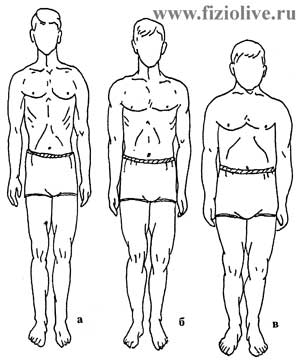
Body types: a — astenik; b — normosthenic; in — hyperstenics (M.V. Chernorutsky, 1938)
Hypersthenic type of Constitution is dominated by the transverse dimensions of the body, the head rounded, the face is broad, the neck short and thick, the chest broad and short, the abdomen large, limbs short and thick, skin tight.
Asthenic type of Constitution is characterized by the predominance of longitudinal dimensions of the body. At astenikov narrow face, long and thin neck, long and flat thorax, small abdomen, thin limbs, poor muscle, thin pale skin.
Normosthenic type of Constitution is characterized by a proportional physique.
The observed dependence of the type of constitutional human rights and his exposure to various diseases. So, at astenikov more common tuberculosis, gastro-intestinal tract, the hyperstenics — metabolic disease, of the liver, hypertension, etc.
Conrad (1963), based on morphological characteristics, identifies the following body types in athletes: leptomorph, telemart, micromorph, metromorph (depending on the degree of manifestation of dalicho and brahamanism).
It should be noted that distinct body types in athletes are rare. Often various combined forms with a predominance of signs of one type or another physique. However, there are specific body types for specific sports. So, basketball players are tall, weightlifters, throwers — a massive, gymnastics is dominated by stunted, etc.
The level of physical development is determined by a set of methods based on measurements of morphological and functional signs. Distinguish between basic and additional anthropometric indices. K former include height, body weight, chest circumference (at the maximum inhalation, pause and exhalation maximum), strength of hands and Stanovaya power (strength of back muscles). In addition, the main indicators of physical development include determining the ratio of "active" and "passive" tissues of the body (lean mass, total fat) and other indicators of body composition. K additional anthropometric indicators include the growth of the sitting, neck circumference, belly size, waist, thigh and calf, shoulder, sagittal and frontal diameters of the chest, arm length, etc. Thus, anthropometry includes the determination of lengths, diameters, circumferences, etc.
The growth of sitting and standing is measured by a stadiometer (see Fig. Measuring height in the standing and sitting). When measuring growth in standing the patient gets back to a vertical stance, touching her heels, buttocks and interscapular area. The Ouija Board is lowered until contact with the head.
Measuring height when standing and sitting
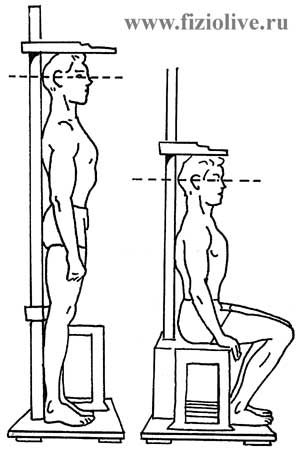
When measuring growth sitting the patient sits on the bench, touching upon the upright buttocks and interscapular area.
Measuring height in the sitting position when compared with other longitudinal dimensions gives an idea of the proportions of the body. With the help of anthropometry determine the length of individual body parts: upper and lower limbs, the length of the body. To conduct these measurements help taken in anthropology anatomical points on the body (see Fig. Anthropometric points). To determine any longitudinal size you need to know where the top and bottom points bounding the size. The difference between them is height and the sought-for value.
Anthropometric points
The body length can vary significantly under the influence of physical activity. So, in basketball, volleyball, high jump, etc. body growth in length accelerates, while in the weightlifting, gymnastics, acrobatics — is slowing down. Therefore, the growth is a benchmark for selection to practice one or another sport. Knowing the length of the body in standing and sitting position, it is possible to find the coefficient of proportionality (KP) of the body.
KP = ((L1 — L2) / 2) x 100
where: L1 — is the length of the body standing, L2 — the length of the body sitting.
Normal KP = 87-92%, in women it is slightly lower than that of men.
Body weight is determined by weighing medical scales on a lever. Body weight total expresses the level of development of the musculoskeletal system, the subcutaneous fat layer and internal organs.
Head circumference, chest, shoulder, thigh, drumstick, measured with measuring tape (see Fig. Measurement of circles).
Measurement of circles
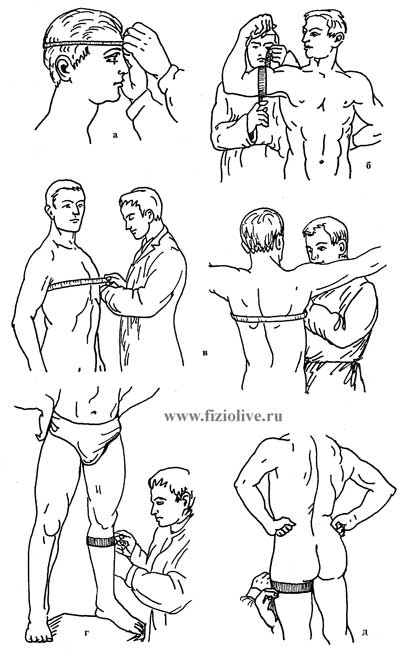
Measurement of head circumferences (a) shoulder (b) chest (in); tibia (g), thighs (l)
Muscle strength of the hands characterizes the degree of development of muscles and is measured by manual dynamometer (in kg). Make 2-3 measurements, record the highest. The rate depends on the age, sex and sport, which deals with the subject.
Stanovaya strength determines the strength of the extensor muscles of the back and backbone is measured by dynamometer. Contraindications for the measurement of backbone strength: hernias (inguinal and umbilical, hernia Shmorlja, etc., menstruation, pregnancy, hypertension, myopia (-5 and more), etc.
To measure the diameter of the compass tolstonnye (large and small). Scale reading is conducted while fixing the caliper in position.
Studies of physical persons engaged in physical culture and sports, have the following tasks:
- Assessment of the impact on the body of systematic physical training and sports;
- Selection of children, adolescents to practice in some sports;
- Control over the formation of the specific features of physical development of athletes on their way from beginner to master of sports.
K now, we have developed a large number of diagrams, scales, types, classifications (V. V. Bunak, M. V. Chernorutsky, V. P. of Readers, etc.) for defining and determining the overall size, proportions of the body, the Constitution and other somatic characteristics of a person.
In recent years, a valuation indices, derived by comparison of different anthropometric characteristics. As such estimates do not have the anatomical and physiological study, they are used only during large-scale population surveys, for the selection in the section, etc.
The Index, Broca-Brugsch:
growth — 100 with the growth of 155 to 165 cm,
growth — 105, with the growth of 166-175 cm,
growth — 110 at the height of 175 and above.
Vital index = VC (ml) / weight (kg)
Average ratio for men is 65-70 ml/kg for females — 55-60 ml/kg for athletes 75-80 ml/kg, for female 65-70 ml/kg.
The differencing index is determined by subtracting from the size of the growth sitting leg length. The average for males 9-10 cm, for women — 11-12 cm. the smaller the index, the consequently greater length of the legs, and Vice versa.
Weight-height Quetelet index:
weight (g) / height (cm)
Average rate — 370-400 g per 1 cm of growth in men, 325-375 — women. For boys 15 years — 325 g per 1 cm, for girls of the same age is 318 g per 1 cm growth.
Index of skellie Manovra characterizes the length of the legs.
IP = (length of legs / height sitting) x 100
The value of up to 84.9 indicates short legs, 85-89 — on average, 90 and above is about long.
Body mass (weight) for adults is calculated by the formula of Bernhard:
Weight = (height x bust) / 240
The formula takes into account features of the physique.
If the calculation is made according to the formula of Broca, after calculations from the result, subtract about 8%: height — 100 — 8%.
Weight-height index is determined by dividing the weight in grams to the height in centimeters:
| The number of grams per centimeter growth | BCS |
| More 540 | Obesity |
| 451-540 | Excessive weight |
| 416-450 | Overweight |
| 401-415 | Good |
| 400 | Best for men |
| 390 | Best for women |
| 360-389 | Average |
| 320-359 | Bad |
| 300-319 | Very bad |
| 200-299 | Depletion |
Life value = VC (ml) / body weight (kg)
The higher the ratio, the better developed the respiratory function of the thorax.
W. Stern (1980) suggested a method of determining fat in athletes.
Percent fat = [(body weight — lean body weight) / body weight] x 100
Lean body mass = 98,42 + [1,082 (body weight) — 4.15 in (waist)]
According to Lorentz formula, ideal body weight (M) is:
M = R — (100 — [(R — 150) / 4])
where: R — the height of a man.
The index of proportion of development of thorax (index Erismana):
the circumference of the chest in the pause (cm) — (height (cm) / 2) = +5.8 cm for males and +3.3 cm for women.
The difference, if it is equal or above the mentioned figures, indicating good development of the chest. The difference below, or with a negative value indicates uskoglazye.
There is a certain correlation between body mass and muscle strength. Generally, the greater the muscle mass, the more force:
[the force of brush (kg) / body weight (kg)] x 100
Dynamometry hands on average 65-80% of body weight in men and 48-50% in women.
Indicator fortress build (Pinje) expresses the difference between the growth of standing and the amount of body weight and circumference of chest:
X = Р — (B+O)
where: X is the index, P — height (cm), B - body weight (kg), O - chest circumference in the expiratory phase (cm). The smaller the difference, the better the indicator (in the absence of obesity).
The difference is less than 10 is evaluated as a hard Constitution, from 10 to 20 — good, 21 to 25 — average, 25 to 35 weak, 36 more — very weak.
Index of proportionality of physical development = (increase in standing — sitting growth / growth sitting) x 100
The value index allows us to judge the relative length of the legs: less than 87% of small length relative to the length of the body, 87-92% proportional physical development, more than 92% is a relatively large length of the legs.
The rate of development of force of muscles of the back = [Stanovaya dynamometry (kg) / weight (kg)] x 100
Small power back — less than 175% of their weight, below average strength is from 175 to 190%, the average power of 190 to 210%, above average power from 210 to 225%, big power to over 225% of its weight.
Measurement of skin-fat folds
Measurement of skin-fat folds is essential when selecting in the section of gymnastics, ballet, etc. Conveniently and objectively enough to determine the thickness of skin-fat folds by caliper.
Thickness of skin-adipose folds depends on the age, sex, physique, professional activities, sports, food, etc.
The measurement is performed on the right side of the body. The skin fold firmly squeeze your thumb and forefinger or three fingers so that it included the skin and subcutaneous fat layer. The fingers have approximately 1 cm above the place of measurement. The legs of the caliper is applied so that the distance from a crest crease to a point of measurement approximately equal to the thickness of the folds.
To determine the composition of body weight is recommended to measure the thickness of fat folds so:
1) under the lower angle of the scapula tuck is measured in an oblique direction (from top to bottom, from inside to outside);
2) on the back of the shoulder crease is measured with a lowered hand in the upper third of the arm (triceps area, closer to inner edge) — the fold is taken vertically;
3) on the anterior surface of the shoulder crease is measured in the upper third of the inner surface of the shoulder (the area of the biceps muscle, the fold is taken vertically);
4) on the anterior-surface at the widest point — the fold is taken vertically;
5) on the front surface of the chest is measured under the fold of the pectoral muscle on the anterior axillary line — the fold is taken in an oblique direction (from top to bottom, from outside to inside);
6) on the anterior wall of the stomach fold is measured at the navel on the right at a distance of 5 cm is taken vertically;
7) at the hip crease is measured in the sitting position, legs bent at the knee joints at a right angle — fold is measured at the top of the thigh on the anterolateral surface parallel to the course of the inguinal folds, slightly below it;
8) on the tibia fold is measured from the same starting position as the hip is taken almost vertically on the posterolateral surface of the upper part of the right tibia at the level of the popliteal fossa;
9) on the dorsal surface of the wrist crease measured at the level of heads of the third finger. The thickness of the subcutaneous fat layer is defined as 1/2 of the average value of all measurements.
To calculate body density according to the regression equation, the output Paskall et al. (1956), it is recommended to proceed from the thickness of subcutaneous fat folds measured in three places: 1) on the mid-axillary line at the level of the xiphoid process of the sternum (T-thorax); 2) on the breast midway between the anterior axillary line and the nipple (M-mammalia); 3) on the rear surface of the shoulder (A.-arm).
Body density (D) can be calculated according to the formula and Pascall matches:
D = 1,088468 — 0,007123 T — 0,004834 M — 0,005513 A
where: T, M, A the specified thickness of fat folds in centimeters.
The composition of the body weight depends on physical activity and nutrition. To properly evaluate changes in the composition of the body weight, it is necessary to know the composition of tissues. K active body weight include cellular water (liquid), all proteins and all the mineral salts in the cells and in the extracellular fluid (outside skeleton). K inactive body weight is considered body fat, bone mineral and extracellular salt water.
To identify the composition of the body weight usually determine total and subcutaneous fat, and skeletal muscle mass in absolute and relative terms. Measurement of thickness of subcutaneous fat can accurately determine these indicators by calculation.
Reliablythe absolute fat content is determined by Matiegka's formula (1921):
D = d x S x k,
where: D — total fat (kg), d — average thickness of subcutaneous fat with skin (mm), S — body surface (cm2) (see Fig. Nomogram for determining body surface according to their height and body weight), k - is a constant equal to 0.13, obtained experimentally on anatomical material. The average thickness of the subcutaneous fat with the skin is calculated as follows:
d = (d1 + d2 + d3 + d4 + d5 + d6 + d7 + d8) / 16
where: d1...d8 — thickness of skin fat folds (mm) on the front shoulder (d1), on the rear shoulder (d2), forearm (d3), supine (d4), stomach (d5), thigh (d6), on the tibia (d7), breast (d8).
Nomogram for determining body surface in growth and body weight
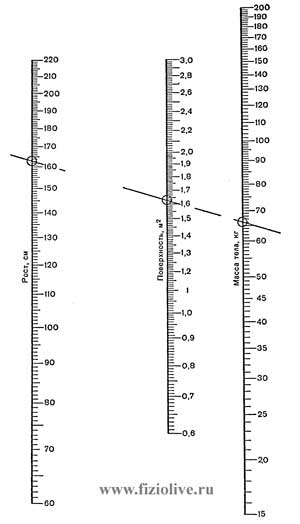
Nomogram for determining body surface in growth and body weight (Du Bois, Boothby, Sandyford)
To determine d in women using 7 folds, d8 not measured. Accordingly, in the denominator of the formula of figure 16 is replaced by 14.
This method of determining total body fat can be used in people of different sex aged 16 and over.
The relative content of fat in percentage of body weight is determined by the formula:
body fat percentage = (D x 100) / W
where: D — all the fat (kg), W is body weight (kg). To determine the percentage of fat content convenient to use the tables proposed Pazziskova (1961).
To determine the mass podlinshe fat usually use Matiegka formula:
D = 0,9 х S х d1
where: D — the subcutaneous fat (kg), S - is the absolute body surface area (cm2), d1 - is the average thickness of the subcutaneous fat without skin (mm).
d1 = (8 skin folds / 16) — (skin fold on the back surface of the brush / 2)
A 0.9 — a constant for the specific weight of fat.
To determine the absolute muscle mass using the formula of Matiegka (1921):
M = L х r2 х k
where: M - is the absolute mass of muscle tissue (kg), L - is body length (cm), r - is the average radius of the shoulder (a), forearm (b), hips (C) and tibia (g), without subcutaneous fat and skin (cm); k - is a constant equal to 6.5.
The radii of the segments of extremitate (r) is calculated by measuring respective girths with less of the average thickness of subcutaneous fat:
(the sum of the girths a, b, c, d / 25,12) — (sum of the thickness of the fat folds (a) front, (b, c, d) back / 100)
To determine lean body mass (LВМ) use the formulas:
LВМ for men = 0,676 L — 56,6 ± 6.7 kg
LВМ for women = 0,328 W + 21,7 ± 4.2 kg
where: L — length of body (cm), W - is body weight (kg).
Muscle strength is determined by the maximum manifestation of the force that can develop muscle group in certain conditions. Usually at the same time a group of muscles, so it is difficult to accurately determine the work each individual muscle to the total force. In addition, the action of the muscles involved bone levers.
There are three types of muscle contractions: isometric, concentric (geometricheskoe) and eccentric (idiomaticheskih). Contraction of the muscle in which it develops tension but does not change its length is called isometric. This reduction is manifested in the form of the static force. Measure concentric strength is the maximum resistance that the muscle is able to overcome on the way of the proper movement. This type of strength is referred to as dynamic. Eccentric strength occurs when the impedance of the external force under the influence of which muscles are stretched, i.e. the length of their increases. For most types of muscular work is characterized auksotonicheskih mode, which combines the reduction and strain.
Determination of the dynamic forces is very difficult, so it is usually limited to the measurement of static (isometric) strength and endurance of muscles.
Men reach the maximum isometric force at the age of about 30 years, then the power decreases. This process goes faster in the major muscles of the lower extremities and trunk. Arm strength remains longer. In the table "Average values of isometric strength in some muscle groups" the indexes of force of different muscular groups, obtained during examination of about 600 people (average height of 171 cm men, women — 167 cm).
The average values of isometric strength of certain muscle groups
depending on the age (E. Asmussen, 1968)
| Indi- cator (kg) |
Age, years | |||||||||
| 20 | 25 | 35 | 45 | 55 | ||||||
| men | wo- men |
men | wo- men |
men | wo- men |
men | wo- men |
men | wo- men |
|
The power brush (В± 16%)* |
55,9 | 37,5 | 59,9 | 38,5 | 58,8 | 38,0 | 55,6 | 35,6 | 51,6 | 32,7 |
The force of the exten- sors of the torso (В± 16%) |
81,6 | 56,6 | 87,4 | 58,3 | 90,7 | 59,2 | 89,8 | 57,7 | 85,7 | 49,1 |
The force of the fle- xors of the torso (В± 17%) |
60,6 | 40,9 | 64,2 | 42,2 | 66,7 | 42,4 | 66,0 | 41,5 | 63,0 | 33,6 |
The force of the exten- sors of the legs while sitting (В± 18.5% ) |
295 | 214 | 310 | 225 | 312 | 212 | 296 | 197 | 263 | 162 |
* The coefficient of variation
Dynamic force can be measured, for example, by the method of lifting weights. The strength of the identical groups of muscles varies in different people. Indicators of strength in adult women is lower by 30-35% in comparison with men.
Power is measured by dynamometers of various designs.
To determine the strength of the brush is usually used dynamometer Collen. The strength of the extensors of the trunk measured using Stanovoy dynamometer. For a more complete view of the muscular system should be further gauge the strength of the muscles of the shoulder and shoulder girdle, razgibatelnyh of the femur and tibia, as well as flexors of the trunk. For this purpose, use a universal torque setting (see Fig. Torque setting to measure the strength of different muscle groups).
The unit for measuring force
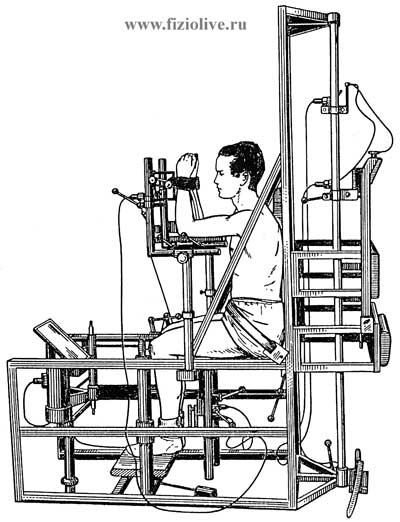
Torque setting to measure the strength of different muscle groups
As a result of the exercise of muscular force increases significantly but decreases with fatigue (especially chronic), various diseases of the musculoskeletal system, during a visit to the sauna (bath), when receiving hyperthermic baths, etc.
Measurement of flexibility (mobility) of the spine.
Flexibility is the ability to perform movements of wide amplitude. A measure of flexibility is the maximum amplitude of movements. Distinguish between active and passive flexibility. Active performed by the subjects, passive under the influence of an external force (in patients — with the help of a practitioner of physical therapy, the sport — trainer). Flexibility depends on the condition of the joints, elasticity (stretch) of ligaments, muscles, age, ambient temperature, biorhythms, time of day, etc.
From a practical point of view most important is the flexibility of the spine, which is determined by measuring the amplitude of movements at maximum flexion, extension, side bending and rotation of the trunk around the longitudinal axis of the body. Usually the flexibility is determined by the person's ability to lean forward, standing on a simple device (see Fig. The measurement of the flexibility of the spine). Moving strap, which is in centimeters plotted your points from zero (at the level of the surface of the bench), indicates the level of flexibility.
The measurement of the flexibility of the spine
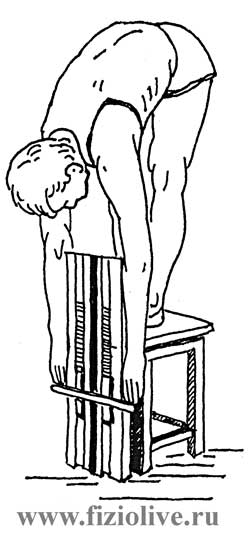
Mobility in the joints is considered to be a moving articulated in the joint bones relative to each other. The degree depends on the shape of the articular surfaces and the elasticity of the musculo-ligamentous apparatus. Joint mobility is detected during passive and active movements. Passive movements are carried out under the influence of unauthorized persons, active — by the man himself. On the value of joint mobility is influenced by age, gender, sport, and hypertonicity of the musculature, diseases of the joints, etc.
The measurements of mobility in the joints branchey use a goniometer consisting of a movable jaws and a gravity goniometer (in degrees). Joint mobility is defined in a state of flexion and extension. In some sports (gymnastics, acrobatics) to increase mobility in the joints apply passive movement (athletes work in pairs or with the help of a coach), which often leads to injuries or diseases of the joints (in subsequent years there is the arthrosis of the joints). The joints are normal physiological mobility (see Fig. Volume of movements in joints), and its increase in violent unsafe for health.
Volume of movements in joints
Range of motion in the joints: a - upper limb; b - lower limb
Posture is anatomically characterized by the shape of the spine, chest, mutual arrangement the belt of the upper extremities, hands, torso, pelvis and lower extremities. In the formation of correct posture a major role played by exercise, nutrition, living conditions and climate and national factors.
Good posture creates optimal conditions for the activity of internal organs, promotes health and, of course, has great aesthetic value.
Characterisation of types of posture can be given on the results of the goniometry of the spine (see Fig. Lotsoptimized in the beginning of the article) and visually.
Power indices are obtained by dividing strength by weight and expressed in percent (%). The mean values of the strength of the hand in men are considered to be 70-75% of weight in women — 50-60%; for backbone strength for men 200-220%, women — 135-150%. In athletes respectively 75-81% 260-300%; female 60-70% and 150-200%.
The differencing index is determined by subtracting from growth sitting leg length. The average for males 9-10 cm, for women — 11-12 cm. the smaller the index, the consequently greater length of the legs, and Vice versa.
When using some other indexes averages require constant adjustment, taking into account fitness, age and gender. And the conclusion is only done for complex survey (ECG, biochemistry, anthropometry, etc.).
Power and toughness — qualities, which is largely determined by the morpho-functional state of the athlete. Question about the power of muscles and their endurance is of great importance. Insufficient development of muscular strength and endurance limits the locomotor capabilities of the athlete.
To study the strength of different muscles and health offered a lot of devices (dynamometers, dynamography, ergography, etc.) of different designs.
The main method of determining muscle strength dynamometry is.
Noted that the development of muscle strength occurs to 25-35 years, and then begins its decline.
It was also found that muscle power during the day varies and that the maximal manifestation of muscle strength is observed when the temperature is +20°. Endurance is the ability to long-term performance. It develops, like other qualities (strength, speed, agility), training (exercise) and is essential to overcome the fatigue that occurs during the execution of work.
One of the important indicators of physical development consider the surface area of the body, which is determined by the formula Issakson (1958) for persons with the sum of the weight and length of body is greater than 160 units:
S = [100 + W + (H — 160)] / 100
where: S - is the body surface area (m2), W — body weight (g), H — body length (cm).
For undersized people with amount of weight and body length less than 160 units use the Boyd formula (Boyd, 1935):
S = 3,207 х H0,3 х W0,7285 — 0,0188logW
where: S — body surface area (cm2), H — body length (cm), W - is body weight in grams.
The surface area of the body it is advisable to consider not in absolute values and in relative, in relation to the mass (weight) of the body (the amount of weight per unit of surface. He is physically strong people per unit area of body surface have more weight than the physically weak (V. B. Bunak, 1940; P. N. Bashkirov, 1958).
The measurement of muscle strength. To map individual values of force of separate muscle groups of persons distinguished by peculiarities of Constitution, it is recommended to calculate the strength of muscle relative to body weight.
Relative strength is calculated by the formula:
Fотн. = Fабс. / W
where Fотн. — relative strength (kg), Fабс. — absolute strength (kg), W is body weight (kg).
Evaluation of speed-power performance can be realized by using a range of simple exercises:
1. Jumping into the Genie (in cm).
2. Vprygivanie on a chair, pushing off with both feet from the floor (number of times).
3. Bending and unbending of hands in the emphasis on sex (number of push-UPS in 15 seconds).
4. Raising the legs at a right angle from vis in straight hands on the gym wall (the number of times in 15 seconds).
5. Pull-UPS (number of times for 10 seconds).
6. Lifting the torso at a right angle (legs locks the partner) from the supine position (quantity of times for over 30 seconds).
7. Lifting of a trunk (bowing) from a prone position on his stomach, arms along the body (the number of times in 15 seconds).
The evaluation of the performance of each exercise receive a comprehensive speed-power-size.
Evaluation. To assess strength endurance is recommended the following exercises:
1. Sit-UPS (number of sit-UPS).
2. Jumping out of the squat in height (the number of jumping).
3. Pulling (number of times).
4. The pressed from the floor (number of times).
5. From the supine position, the transition to the sitting position (number of times).
6. A hang on the gym wall lift straight legs at a right angle (number of times).
A linear dependence of the number of repetitions and muscle strength.
Height and weight index Joske calculated by the formula:
(body weight (kg) x 100) / (height (cm))
Tests for the assessment of joint mobility (flexibility).
Joint mobility (flexibility) is the ability to perform movements with large amplitude of oscillations (with large amplitude). Joint mobility (joints) is determined by the elasticity of his muscles, tendons, ligaments, age, sex, and hereditary factors. Measure the mobility of the Val Gamburtsev goniometer.
For the final section of gymnastics, acrobatics and other sports where flexibility is important, use a test twine is longitudinal and transverse. Behind the examined set the tripod strap which overlies the head. Measure the distance from floor to groin (cm).
The gymnastic wall, the athlete is taken hands for the rake at shoulder level and removes (lifts) leg back. Measure the distance from the floor to the ankle joint (in cm). Even test the bridge. The athlete in the supine position pulls the feet close to the buttocks, hands rests on the shoulders, light breeze upwards. Measure the distance between your palms and heels (in cm) from the floor and back up to (in cm).
In the body of an adult, water makes up 60-70% of body weight. The larger the content of the fat component, the lower the water content. Conversely, the higher the percentage of active body mass, the greater its water content. The water content in different tissues varies. In connective and support tissues it is less than in the liver, the spleen, where it is 70-80% (see table Water metabolism of the body).
Water metabolism of the body
| The flow of water | The allocation of water | ||||
| source | the number | bodies | the number | ||
| ml | % | ml | % | ||
| Liquid | 1200 | 48 | Kidneys (urine) | 1400 | 56 |
| Dense food | 1000 | 40 | Light | 500 | 20 |
| Metabolism (tissue oxidation) |
300 | 12 | Skin | 500 | 20 |
| The intestines (feces) | 100 | 4 | |||
| Just | 2500 | 100 | 2500 | 100 | |
Water enters the body in liquid form (48%) and composed of dense food (40%), the remaining 12% are formed in the process of metabolism of nutrients.
Because women have more fat in the body weight, they water and almost 10% less than men. Lean body contains 73% water, which is considered to be very constant. This water is divided into intracellular fluid and extracellular. Intracellular fluid is 40%, extracellular — 20% of body weight. 15% extracellular fluid accounts for the lymph, synovial, cerebrospinal fluid and the fluid of serous membranes. The share of intravascular fluid accounts for 5% of water. It contains water and plasma water moving red blood cells, vzaimonesmeshivajushchiesja with water plasma. When dehydration (dehydration) red blood cells lose some water, and surplus water in the plasma take some. When dehydration happens, the blood clots and causes microclots. Therefore, it is dangerous to limit yourself to fluid intake during the sauna (bath), during training (especially during competitions) in a hot and humid climate.
Determination of volumes of fluid in the body composition is extremely important for an athlete. Measurement (determination) of the total mass of water is carried out by the method of radioisotopic (tritium, bromine82 and other radioisotopes). The total water content can be determined by the formula E. Osserman et al. (1950):
% water = 100 x (4,340 — 3,983/d)
where: d - is the specific weight of the body.
E. Osserman et al. (1950) noted that in healthy men aged from 18 to 46 years contains 71,8% water. Mellits E. D. A. Cheek (1970) proposed the equation to calculate the amount of water and fat in the body based on anthropometric data. They examined people at the age from 1 year to 34 years and established a linear dependence of the water content (in liters) in the body from body weight (in kg):
for men
total water content = 1,065+0,603 x (body weight);
for women
total water content = 1,874+0,493 x (body weight).
To obtain more accurate data, the authors recommend the use of equations involving body weight and growth:
for men, the growth of which more 132,7 cm, total water content = -21,993+ 0,406 x (body weight)+0,209 x (height);
if the person is less 132,7 cm, the total water content in his body = -1,927+of 0.465 x (body weight)+ 0,045 x (height).
for women, the growth of which more 110,8 cm, total water content = -10,313+ 0,252 х (body weight)+0,154 х (height);
if growth is less than 110,8 cm, total water content = 0,076+0,507 x (body weight)+0,013 x (height).
The formula for determining the water content in the body weight also featured on the website http://www.medcalc.com/tbw.html
Thus, studies with measurement of different anthropometric parameters in individuals involved in physical activities and sports can help monitor the growth and development of their physical performance. From the point of view of health, of particular importance is the assessment of the musculature and posture.
V.I. Dubrovsky,
Academician of the Russian Academy of Natural Sciences,
IANPO and the New York Academy of Sciences,
Doctor of Medical Sciences, Professor,
A.V. Dubrovskaya, pediatrician
It is available for the original version
of the article in Russian
<< Previous: sports, featured articles
We recommend that you look at the popular sections of the site myvaleology.com: MENU with a description of the sections | |||
| SOCIAL | DONATION | MY DIET | MY SPORT |


|
Release all4e8 |
||
Copyright © VZOJ 2023. All rights reserved. When reprinting or quoting myvaleology.com materials please put a link to the site myvaleology.com :
<a href="https://myvaleology.com">Healthy lifestyle</a>